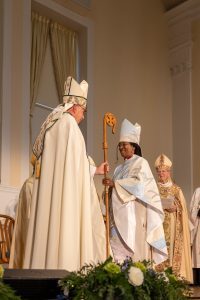Dear colleagues,
One of the most symbolic moments of the consecration of a new bishop occurs when the outgoing bishop hands over the crozier (or, more colloquially, shepherd’s crook) to the new bishop. It symbolizes the transfer of authority from old to new. A few weeks ago, during a wonderful service, the retiring bishop of Vermont, Tom Ely, did precisely this: he handed over his crozier to Shannon MacVean-Brown who had just been consecrated and vested as bishop.
But the moment was freighted with more symbolism than usual. The crozier Bishop Ely handed over was the historic crozier of the bishop of Vermont, the very same one once used by John Henry Hopkins, first bishop of Vermont. As we had been reminded during the service, during the American Civil War Bishop Hopkins had opposed abolitionists and offered a defense of slavery. Bishop Shannon is the first African-American to serve as bishop of Vermont. It was among the most moving moments I have ever seen in a liturgy: who could ever have imagined when John Henry Hopkins was bishop that an African-American (and a woman, at that) would one day hold his crozier?

On the ride home, I found myself thinking about the 1619 Project, a recent collection of articles from The New York Times Magazine marking the 400th anniversary of the arrival of the first slaves in what is now the United States. Among much else, the Project argues that African-Americans are responsible for the perfecting of democracy in the United States, that their struggle for freedom has inspired the continual enlarging of the franchise and extension of rights to marginalized groups. Later in Bishop Shannon’s service we sang “Lift Every Voice and Sing,” a hymn known as the “black national anthem” and one well known to me from my time working in an African-Caribbean church during my M.Div. The second verse has these lines: “Yet with a steady beat / have not our weary feet / come to the land for which our fathers sighed?” Thanks to the faithfulness and weary feet of African-American Christians, this one aspect of the church’s past was here redeemed. (“Yet with a steady beat” is also the title of the definitive history of African-American Anglicanism.)
The Canadian church has its own faithful and weary group as well. The history of indigenous-settler relations in Canadian Anglicanism might not seem to give much hope, to put it lightly, for the future development of indigenous Anglicanism. But recent decades have seen the unfolding of a self-determining indigenous Anglican church in Canada, a process that is very much still in motion.
There is much to write about this, of course. Just as Christians once erred and strayed, Christians continue to err and stray today. Just because one African-American becomes bishop or General Synod changes the canons related to indigenous ministry doesn’t mean systems of racism in the church are overturned. But symbols matter in the church and especially in liturgy. So I will cherish that moment of the crozier handover as a symbol of the kind of redemptive work towards which the church is called, both within itself and in the broader world.
Faithfully yours,
Jesse Zink
Principal
This message was written by College Principal Jesse Zink for this week’s Wingèd Ox, a weekly news digest distributed to the college community.

